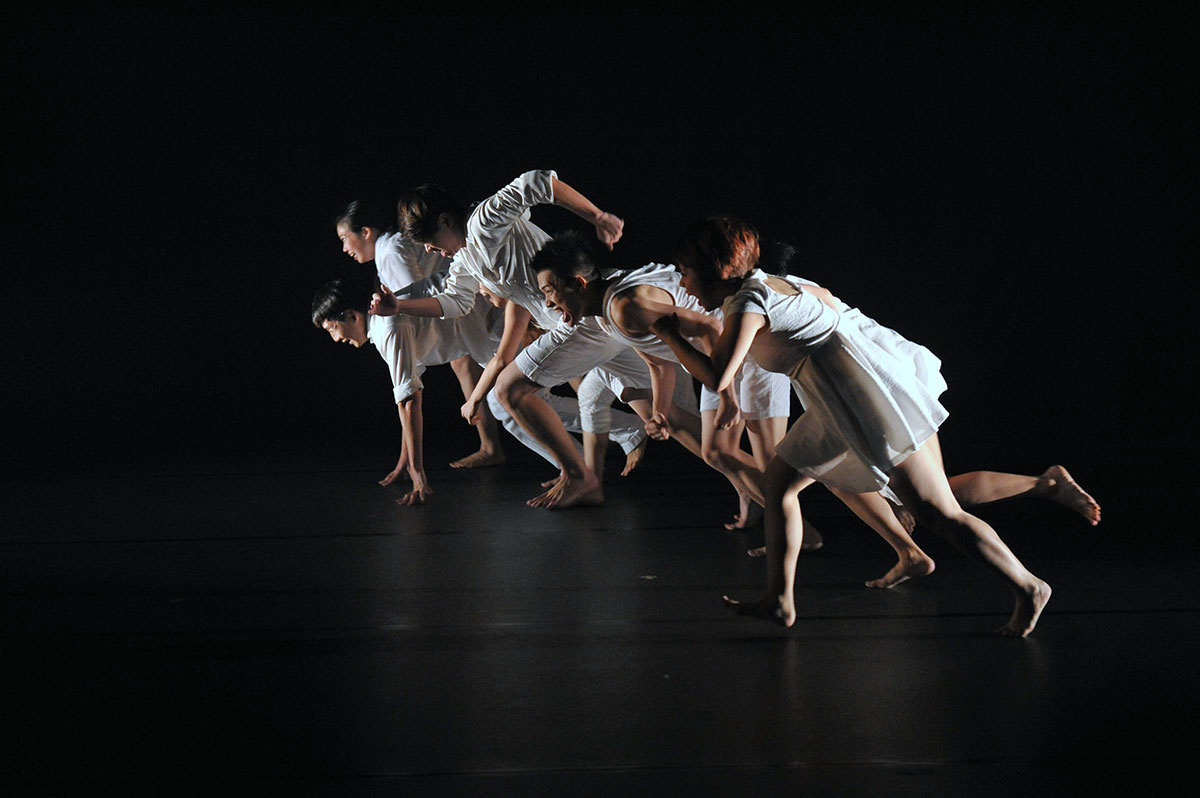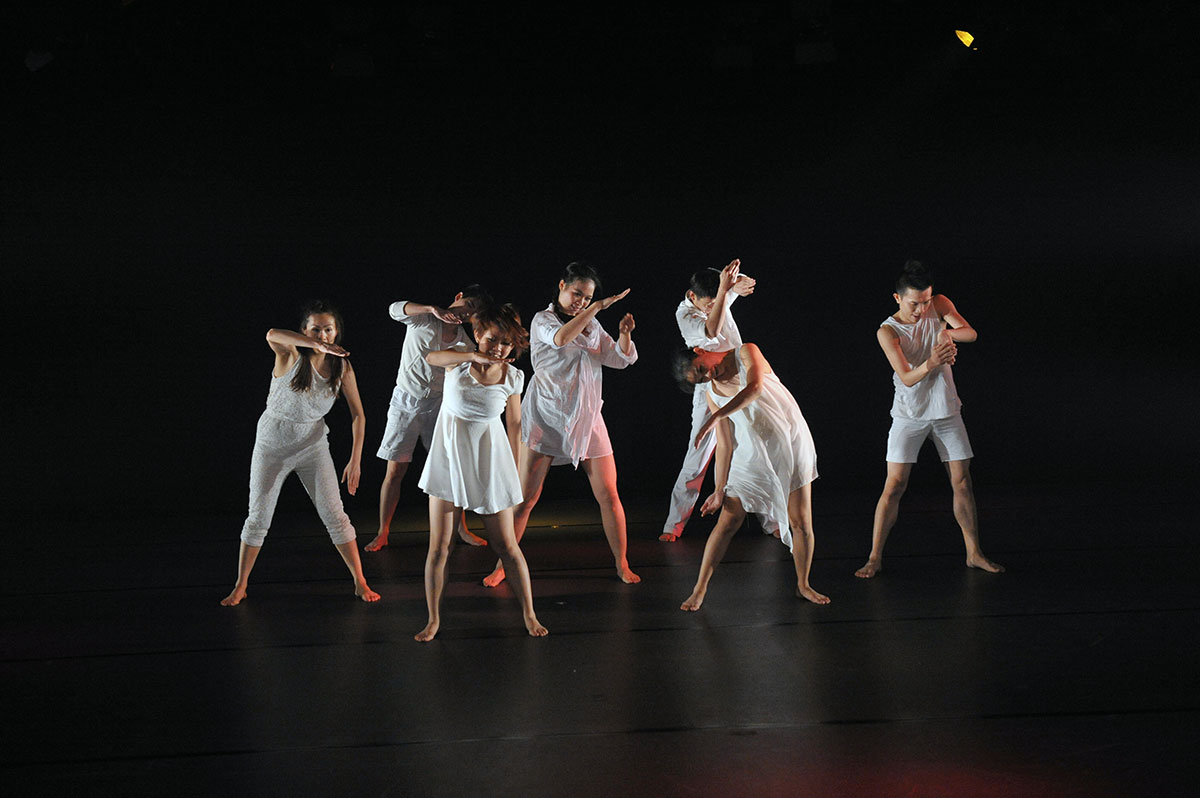Leng Poh Gee reflects on how the gestures and movements of Malay folk dance served as inspiration for his 2013 dance work entitled Belonging.
I have been fascinated with Malay dance since I started to learn Malay folk dance in Universiti Putra Malaya (UPM) as a leisure activity, before I entered formal training in contemporary dance. The refined curl and curve of the arms and hands gestures, the supple twist of the torso, the politeness of couple dances and the controlled improvisation grounded on generic movement motifs depicted the surroundings of my kampong where I grew up in Kelantan. Since then, incorporating elements of Malay folk dance has become one of my inspirations for creation.
The very first piece in which I attempted to do such an integration was in 2002, entitled That Time…, showcased in UPM in conjunction with a Buddhist Society’s event, performed by Mak Foong Ming and Chen Kar Voon, who are now senior dancer and former dancer respectively at Kwang Tung Dance Company. This particular work attempted to combine the curling and reaching out expansive arm movements of Malay dance, with a minimal twist of the torso. This short experimental phrase seized only a small portion of the 4’12” dance. The dance was refined, conceptualized, expanded and performed in various events, at TARI 2007, TanTiaoBan (2008) and recently at the UMa Contemporary Dance Showcase 2014 of the Dance Department, University of Malaya. The initial “copy and paste” methodology for this choreography (deliberately putting recognizable movements from Malay folk dance and codified contemporary dance together) progressively became more ambivalent in terms of movement design in my choreography throughout the years.
In August 2013, with the support of the National Department for Culture and Arts (JKKN)—Kakiseni’s Grant To Reduce Production Costs, LAPAR Lab (the dance company of which I am a founding member) was able to produce Space Bar, a double-bill contemporary dance performance that consisted of Safe Distance, choreographed by Mak Foong Ming, and my dance work Belonging, at Damansara Performing Arts Centre.
In the final scene of Belonging, I once again attempted to create dance derived from Malay folk dance. Kyo Hong, one of the dancers, taught Zapin Kampung Manggis to the cast of Belonging through regular internal sharing sessions. Kyo Hong is a recent graduate of the dance diploma from the National Academy of Arts, Heritage and Culture (ASWARA). The energy and playfulness of the zapin dance cheered us up. Dancers who were familiar with the zapin genre (the graduates from University of Malaya’s dance program) started to compare it with other types of zapin with practical physical involvement, while dancers who were fresh to the genre faced difficulties with the coordination of the stylistic movement with the unconventional counting of the accompanying song based on pantun. The whole atmosphere of having fun triggered in me a desire that this particular moment should be theatricalized in a non-zapin way.
The dynamic zapin involves locomotive footwork and allows fast traveling through a stylistic walk, run and leap. The torso tilts and the arms wave accordingly with the fast transfer of weight in order to maintain balance. Once the LAPAR Lab dancers had acquired the basic technique of the dance form, the process of deriving movement from zapin, in the aim of creating a cheerful piece, began.
When I asked the dancers to replace the footwork, which mostly involved body support on the ground, with pure arm gestures in a static standing position, hilarious moments ensued. Initially, the palms imitated the traveling steps and developed into various complicated arm gestures. The pathways, or pola lantai, which are very important for zapin performance, were illustrated by different parts of the body moving in lines and arcs. Arguments between the dancers who had learned zapin previously and those who were fresh to it turned into a race. I tried hard to avoid including any recognizable movement of Malay folk dance in the piece. Repetition was used significantly in the piece, as it also is in zapin performance. The genuine spontaneity of “playing” (main) zapin in folk dance was also grafted onto the creation. Missteps, habits of personal stylistic movement and daily utilitarian movements that happened in the process were manipulated and put into the choreography. The dance was accompanied by an allegro tempo Chinese pop-song entitled “Qiong Kai Xin”, literally translated as “poor with happiness”. Performed by Hua Er Yue Tuan, the song is self-deprecating, and motivates us to pursue our dreams as if we have nothing to lose. In general, the dancers, who were clear about the initial material developed in rehearsal, rationalized the artistic consensus as one that was about fun, togetherness and encouragement to be kind.
“The final scene is a boisterous bouncy paean to good cheer. The group rushes about, here prancing with their head lolling from side to side, there manically brushing their teeth and windmilling their arms. The music, a retro-Chinese pop song, builds and builds, and the lyrics, even for those who don’t speak Mandarin, are self-evident: ‘Free unfettered souls must laugh every day, although we are poor!’ In the end, exhausted by happiness, the dancers collapse in a circle. After a moment, in a very Poh Gee-like gesture, they quietly help each other up.” (Bilqis, 2013)
Video clips of the particular version of Zapin Kampung Manggis learned by the dancers can be viewed below, which is from a live performance recorded from Main Zapin 2013, organized by ASWARA. A short excerpt from Belonging showing this particular moment can also be viewed below, recorded at the MyDance Festival 2013, organized by MyDance Alliance.
The piece was performed on three different occasions: MyDance Festival 2013 in June 2013, Space Bar contemporary dance performance and the National Chinese Dance Festival in August 2013. None of the audience feedback to us made a connection between the two dance forms, neither did the performers who were added for the third occasion, until we told them.
Using traditional dance as a basis for contemporary creations is hardly a new thing in Malaysian dance. The festival of Inspitari, organized annually by JKKN since 2009, is a platform to encourage the exploration and enrichment of pure dance vocabularies into a full repertoire based on the local customs of every state. These “new creations” (kreasi baru) are hoped to represent every state and to eventually become a part of the Malaysian dance heritage. Experimental works have been created as a part of this series. However, the elaborate celebration of the event also tends towards touristic consumerism, and thus the new creations are constructed with a conventional aesthetic, according to the norms of governmental scripted performativity.
I am lucky enough to have had a little room to make my own piece, and do not mind if the dance fits into the prevailing philosophies of interculturalism or hybridity. I just feel good about the making of this contemporary work which has been stimulated by the Malay dance culture that has so much to do with my current environment. How good? Well, I can equate my nostalgia for the past with my vision for the future.
“Belonging reminds us what it takes to be an ideological youth — 文艺青年. These four words have brought about nostalgia and politics.” (Chua, 2013)
“But its pleasantry is not trite; it is tempered by awareness of a particularly Malaysian absurdity. The pronouncements of national pundits can only make sense like this, in seeing their effect on individuals and our everyday relationships with each other.” (Bilqis, 2013)
 Leng Poh Gee is a lecturer at the Cultural Centre (School of Performing Arts) in the University of Malaya. More
Leng Poh Gee is a lecturer at the Cultural Centre (School of Performing Arts) in the University of Malaya. More
To contact the author:
![]() ;
;
References: Chua, Richard (2013). Life is Simple, with LAPAR Lab Production. Retrieved from http://www.theatrex.asia/life-is-simple-with-lapar-lab-productions/
Bilqis Hijjas (2013). In Praise of Modesty: Ambition, world-class status and us: A review of LAPAR Lab’s Space Bar. Retrieved from http://contentviewer.adobe.com/s/The%20B-Side/dc43599887d043fd8cff1e51c0f2a5da/my.bfm.thebside.2013.september_V2/3404.html
Videos:
Featured photo: Torsos tilted backward, contrary to the norms of the body that is tilted forward in a zapin performance. [Left to right] Matthew Tan Yong Kiean, Lim Hooi Meng, Chow Yong Shuang, Tan Shioa Por, Leo Yap Chee Yee (behind Tan Shioa Por), Lim Siew Ling and Hong Xi Fan in Belonging, Black Box, Damansara Performing Arts Centre, Petaling Jaya, 3 August 2013. Photo © James Quah


